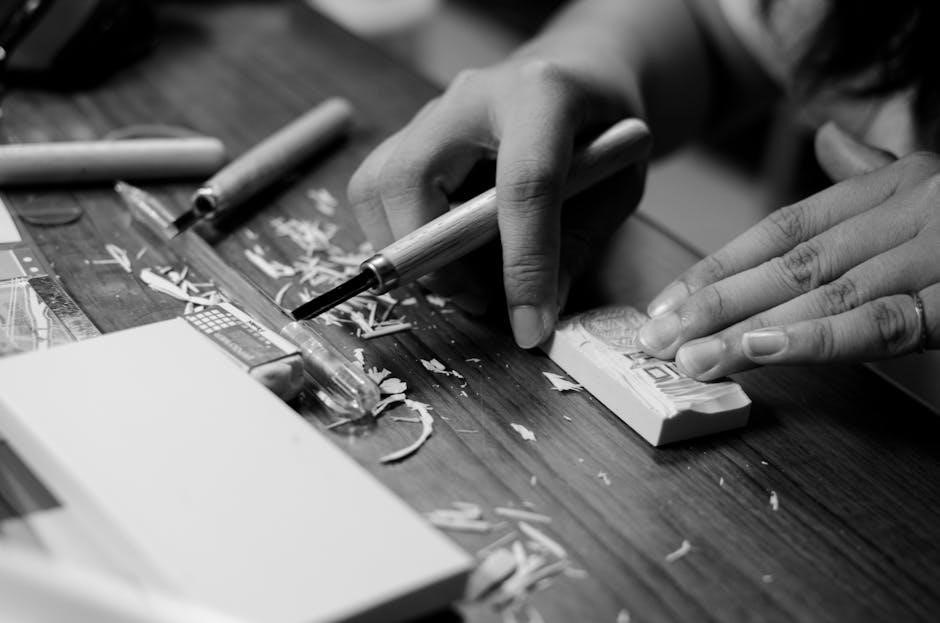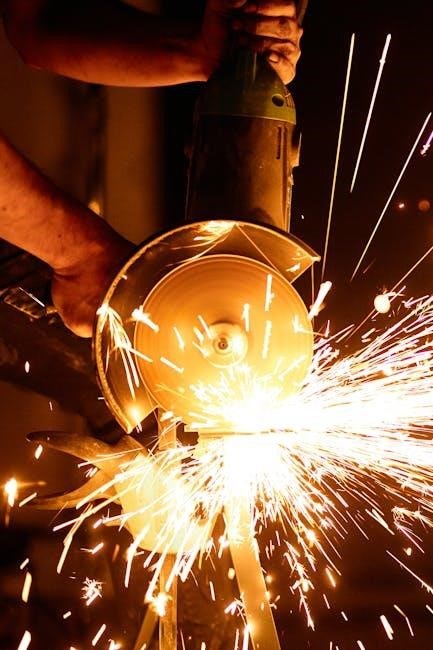Welcome to the comprehensive jigsaw tool manual! This guide provides essential knowledge for both beginners and experienced users. Learn about the jigsaw’s versatility, safety, and cutting techniques. Master making straight, curved, and intricate cuts, and ensure smooth, professional results!
The jigsaw, a versatile power tool, stands as a grand master of cutting for DIYers and professionals. It’s celebrated for its ability to execute both straight and intricate curved cuts across various materials, including wood, metal, laminate, and tile. This introductory section unveils the jigsaw’s fundamental principles and diverse applications.
A jigsaw proves invaluable for craft projects, woodworking tasks, and tackling circles larger than hole saws can manage. Understanding its components is crucial before delving into operation. Familiarize yourself with the blade, motor, base plate, and speed controls to optimize performance. The correct blade selection ensures clean and efficient cuts across different materials.
Jigsaws offer the flexibility to create detailed cuts, making them ideal for projects requiring precision. Whether you’re a beginner or seasoned woodworker, mastering the jigsaw unlocks a world of creative possibilities. This manual will guide you through the essentials, from safety precautions to advanced cutting techniques, ensuring you harness the full potential of this indispensable tool.
Jigsaw Safety: Essential Tips
Prioritizing safety is paramount when operating a jigsaw. Always ensure the tool is switched OFF before plugging it in or connecting the battery. This prevents accidental startups and potential injuries. Before commencing any cutting task, meticulously inspect the jigsaw for any signs of damage or wear. Replace worn or faulty parts immediately to maintain optimal performance and safety.

Handling the jigsaw correctly is as much about safety as it is about precision. Wait for the blade to reach full speed before initiating the cut, minimizing the risk of kickback. Employ both hands, one to guide the tool and the other to steady it, ensuring consistent control throughout the process. Wear appropriate safety gear, including eye protection and a dust mask, to shield against debris and airborne particles.
Secure the workpiece firmly using clamps or a vise to prevent movement during cutting. A stable workpiece enhances control and reduces the likelihood of accidents. Never force the jigsaw; allow the blade to do the work. Overexertion can lead to blade breakage or loss of control. By adhering to these essential safety tips, you can confidently and safely utilize your jigsaw for a variety of projects.
Preparing the Jigsaw and Blade

Proper preparation is crucial for achieving optimal results with your jigsaw. Begin by selecting the appropriate blade for the material you intend to cut. Different blades are designed for wood, metal, laminate, and tile, each with specific tooth configurations and materials. Ensure the blade is securely installed in the jigsaw, following the manufacturer’s instructions. A loose blade can lead to inaccurate cuts and potential hazards.
Before starting, inspect the blade for any signs of damage, such as bent teeth or cracks. A damaged blade should be replaced immediately to prevent further issues. Adjust the jigsaw’s settings according to the material’s thickness and density. Variable speed settings allow for greater control and precision, especially when working with delicate materials.

For plunge cuts, ensure the jigsaw is equipped with a plunge-cutting feature and that it is properly adjusted. Always make sure the saw is unplugged before putting the blade into the jigsaw. Some jigsaws have a bolt that needs to be loosened with an Allen wrench. By taking the time to properly prepare your jigsaw and blade, you’ll set yourself up for success and achieve clean, accurate cuts every time.
Step-by-Step Guide to Cutting with a Jigsaw
Embarking on a jigsaw project requires a systematic approach. Begin by marking your cutting line clearly on the material. Use a pencil and a straight edge for straight cuts, or a template for curved lines. Secure the material firmly to a workbench using clamps to prevent movement during cutting; This ensures stability and accuracy.
Position the jigsaw so that the blade is aligned with the marked cutting line. Before starting the saw, ensure the switch is in the OFF position before plugging it in. Engage the jigsaw and allow the blade to reach full speed before making contact with the material. Gently guide the jigsaw along the cutting line, applying consistent pressure. Avoid forcing the saw, as this can lead to blade breakage or inaccurate cuts.
Maintain a steady pace and keep the base of the jigsaw flat against the material’s surface. For thicker materials, consider using a slower speed setting to prevent overheating. Handling the jigsaw correctly is as much about safety as it is about precision. If you need to pause the cut, stop the saw completely before lifting it from the material. By following these steps, you can achieve clean and precise cuts with your jigsaw.
Mastering Curved Cuts
Cutting curves with a jigsaw demands finesse. First, select a blade designed for curved cuts; these blades are narrower and more flexible. Clearly mark your curved line on the material. For intricate designs, consider using a template. Secure your workpiece firmly to prevent shifting during the cut.
Start the jigsaw and gently guide it along the marked curve. The key to smooth curves is to let the blade do the work. Avoid forcing the saw, as this can cause the blade to bend or break. Instead, use a slow, steady pace, and allow the blade to follow the curve. If the saw starts to bind, make relief cuts along the waste side of the curve. These cuts relieve pressure and allow the blade to turn more easily.

For tighter curves, you may need to use a series of short, controlled cuts, pivoting the saw slightly after each cut. Remember to maintain a firm grip on the jigsaw and keep the base plate flat against the material. Practice on scrap material to develop your technique and get a feel for how the saw handles curves. With practice, you’ll be able to create smooth, flowing curves with confidence.
Tips for Clean Cuts
Achieving clean cuts with a jigsaw requires careful preparation and technique. Begin by selecting the appropriate blade for the material you are cutting. For wood, a fine-tooth blade will minimize splintering. For metal, use a blade with a higher TPI (teeth per inch). Always ensure the blade is sharp and in good condition. A dull blade will tear the material, resulting in a rough cut.
Before cutting, apply masking tape along the cut line. This helps to prevent splintering, especially on delicate materials like plywood or laminate. Use a sharp utility knife to score the cut line through the tape. This creates a clean edge for the blade to follow. When cutting, use a variable-speed jigsaw and adjust the speed according to the material. Lower speeds are generally better for hard materials, while higher speeds are suitable for softer materials.
Maintain a steady, consistent feed rate. Avoid pushing the saw too hard, as this can cause the blade to wander or bind. If you are cutting a long, straight line, use a guide to ensure accuracy. A simple straightedge clamped to the workpiece can help you maintain a consistent line. Finally, consider using a jigsaw with an orbital action setting. This setting moves the blade forward and backward as it cuts, resulting in a faster, cleaner cut.
Avoiding Splintering and Rough Edges
Splintering and rough edges are common problems when using a jigsaw, but they can be minimized with the right techniques. One of the most effective methods is to use a sharp, fine-tooth blade specifically designed for the material you’re cutting. A dull blade will tear the wood fibers, leading to splintering. For delicate materials like plywood or veneer, consider using a down-cutting blade, which cuts on the downstroke, pushing the material fibers together instead of pulling them apart.
Before making the cut, apply masking tape or painter’s tape along the cut line. This provides a protective layer that helps to prevent the wood from splintering. Score the cut line with a utility knife before sawing. This creates a clean, crisp edge that guides the jigsaw blade and reduces the likelihood of tear-out. When cutting, maintain a slow, steady feed rate.
Avoid forcing the jigsaw, as this can cause the blade to vibrate and tear the wood. If possible, clamp a piece of scrap wood to the underside of the workpiece to provide additional support and prevent splintering as the blade exits the cut. Experiment with different jigsaw settings, such as orbital action, to find the setting that produces the cleanest cut for your material.
Jigsaw Maintenance and Blade Care
Proper maintenance and blade care are crucial for extending the life of your jigsaw and ensuring optimal performance. Regularly clean your jigsaw after each use to remove sawdust and debris, preventing build-up that can hinder its operation. Use a soft brush or compressed air to clean around the blade clamp, motor vents, and other moving parts. Lubricate the blade clamp mechanism periodically with a light machine oil to keep it functioning smoothly. Check the power cord for any signs of damage, and replace it if necessary.
Jigsaw blades are consumable items, so regular inspection and replacement are essential. Examine blades before each use for signs of wear, such as dullness, bent teeth, or cracks. Dull blades can cause splintering, rough cuts, and increased strain on the jigsaw motor. Replace blades as soon as you notice any signs of wear. Store jigsaw blades in a dry, organized manner to prevent rust and damage.
Consider using a blade case or a blade organizer to keep your blades separate and easily accessible. When changing blades, always unplug the jigsaw or remove the battery to prevent accidental start-up. Follow the manufacturer’s instructions for blade installation and removal. Ensure the blade is securely clamped in place before using the jigsaw. Periodically inspect the jigsaw’s base plate for flatness and adjust it if necessary to ensure accurate cuts.




Be the first to reply